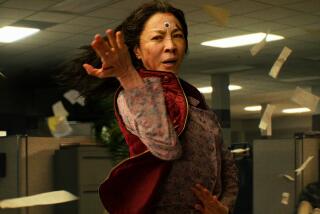Optical Radiation Sets Its Sights on New Movie Sound
- Share via
Optical Radiation Corp. got its start making military searchlights in 1969. Now, the Azusa-based company hopes to find itself behind a different kind of searchlight--the ones outside movie theaters.
Last week, ORC premiered for Hollywood executives a new digital sound system for movie theaters: Cinema Digital Sound. The system, which ORC and partner Eastman Kodak Co. have spent three years developing, seems to have wowed virtually everyone who’s heard it.
“I thought it was phenomenal,” said Maryann Grasso, executive director of the National Assn. of Theatre Owners. At Pacific Theatres Corp., Vice President Milton Moritz calls CDS “pure sound, with no distortion. We were very, very impressed”--enough so that Pacific wants to get the system into its Cinerama Dome in Hollywood and in the Crest Theatre in Westwood “as soon as possible,” Moritz said.
In essence, CDS is compact-disc-quality sound in the theater. The highs and lows are crystal clear, and when a movie scene calls for silence, that’s what the audience gets--absolute silence.
The system has the potential to be an earnings blockbuster for ORC. Yet the company’s stock may not reflect much of that potential, despite soaring from a low of $13 last year to $31.75 now.
That’s why ORC remains an intriguing investment idea: Investors have largely been reacting to an improving picture for the company’s other assorted optical businesses--eye wear, medical products and scientific equipment--which should see total sales of $125 million this year. The digital sound venture could be pure gravy, if it sells.
Of course, theater owners have always been a cautious bunch, and producers aren’t easily bowled over by promises of wild new advances in theater technology. So why think the CDS system will become a theater standard in the 1990s?
The partnership with giant Kodak is the key. What makes CDS unique is that the sound signals are optically recorded on the film itself. So the synchronization of sound and image is perfect. In other uses of digital sound in theaters, the sound system was separate, and synchronized manually.
What’s more, the new film opens the door to a host of other interesting applications in the theater. Controllers hooked up to the projector could turn speakers on and off, dim lights or brighten them, and raise or lower curtains--all on cue from signals encoded on the film.
The sound, however, is the major lure. ORC and Kodak see the new system as a natural step for the theater industry, a way to enhance the movie-going experience. Hollywood doesn’t have to change the way it makes movies, because the adaptation to the new film is done after production. For the theaters, the cost is about $15,000 for a decoder needed to adapt a 70-millimeter projector for the new film--a price that Pacific Theatres’ Moritz terms “certainly not out of this world.”
ORC will make money off its decoders and from royalties on the films that use the technology. Kodak will get about 15% of the royalties. Meanwhile, deep-pocketed Kodak is footing the bill for most of the promotion for CDS, including a big bash next week at the Cannes Film Festival.
ORC’s 50-year-old chief, Richard D. Wood, will host Wall Street analysts at the firm’s 15-acre office and production complex in Azusa on Tuesday. He believes that the technology is attractive enough--and affordable enough--to become the theater standard. The first major studio agreement should be announced at Cannes, he said.
What’s the new sound system potentially worth for ORC’s bottom line? Wood figures it this way: There are 18,000 first-run theater screens in the United States. About 1,000 are 70-millimeter theaters, ORC’s initial target market. Of the rest--the 35-millimeter theaters--many would have to upgrade their sound systems for CDS. The system won’t be available for the 35-millimeter format until early 1991.
In addition, there are 150 to 200 major U.S. film releases a year, which also would be Wood’s target market. International business would add to that.
Wood believes he can convert enough theaters and producers in the fiscal year starting Aug. 1 to significantly offset the continuing development costs of CDS. Late 1991 is when the earnings contribution would begin to be substantial, he said.
Why should Hollywood pay ORC royalties--perhaps $100,000 per film--for digital sound? Wood admits he’s got a selling job to do. But he’s convinced that theater patrons will speak for him, via higher ticket sales at CDS theaters.
“We originally thought we could add $20 million in sales (annually) with digital sound,” he said. “We now recognize that the potential is much greater than that. At the $30 million to $40 million range, I could see this clearly being a $1-a-share (earnings) product.”
But even assuming that estimate is too high, ORC’s basic optical business now looks healthy enough to support strong earnings growth. After three years of sluggish results--a rebuilding phase at ORC--the company should earn $1.70 a share this year (ending July 31) from operations. That will be reduced by about $1 a share for a reserve that the company has to set up for a patent suit it lost, which Wall Street already knows about.
In the fiscal year starting Aug. 1, analyst Leonard Yaffe at Montgomery Securities in San Francisco sees earnings rising to $2.05 a share, then to $2.40 in the following year. And none of those estimates includes much benefit from CDS, Yaffe said. So at $31.75 a share, the stock trades for about 15 times next year’s earnings, a price-to-earnings ratio not much above the market average.
What you get for that price is a company with low debt and $30 million in cash, looking ahead to “three good years of solid, consistent growth,” Yaffe said:
* ORC’s principal business--plastic prescription eye wear--should grow 25% a year over the next three years, according to Wood. ORC has spent four years turning its Dallas-based Omega eye-wear unit from a money loser to a money maker. The key: New quality controls, and a successful campaign to market new models to optometrists. ORC’s LiteStyle lenses are scratch-resistant and one-third the weight of glass. Its Mirage lenses are anti-reflective, a market only beginning to bud.
Omega now is the world’s largest independent processor of prescription eye wear and should earn $3 million pretax this year on $50 million in sales, versus just breaking even last year, Yaffe said.
* ORC’s intraocular lens business--lens implants for cataract patients--is a cash cow thanks to the aging population, Yaffe said. ORC also has a promising new product in Orcolon, awaiting federal approval. Orcolon, a synthetic substance used to protect eye tissue during surgery, could be a “very significant product for us,” Wood said.
* The company’s lamp business, specialized equipment for theaters and other uses, should continue to fuel 15% to 20% annual growth in ORC’s scientific and industrial division, Wood said.
Wood, clearly excited about ORC’s possibilities, also has a big personal bet on the company’s success: He owns 15% of ORC’s 6.6 million shares.
More to Read
The biggest entertainment stories
Get our big stories about Hollywood, film, television, music, arts, culture and more right in your inbox as soon as they publish.
You may occasionally receive promotional content from the Los Angeles Times.










